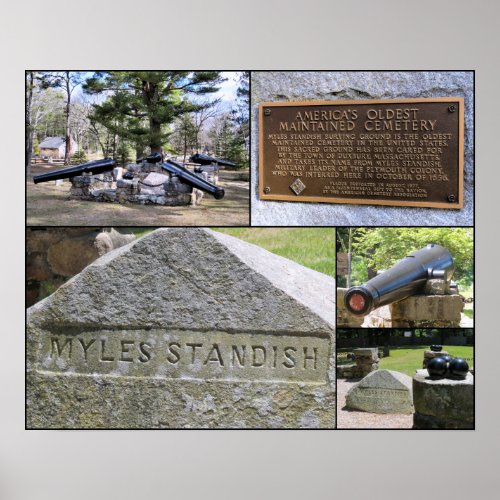Myles Standish Burying Ground Poster



Collage of five of my photographs - Myles Standish Burying Ground in Duxbury, Massachusetts "As interest in the Old Burying Ground increased during the late 19th century, visitors to Duxbury frequently inquired after the grave site of Captain Myles Standish, leader of the Pilgrim militia and one of the first settlers of Duxbury. In the 1880s, there was considerable debate as to the final resting place of Capt. Standish. After much research, it was generally agreed that Standish was buried beneath two pyramidal fieldstones in the center of the Old Burying Ground. To determine for certain whether the strange stones in fact marked the Standish family plot, the Duxbury Rural Society decided to exhume the graves beneath the stones in 1889. The project was controversial and proceeded only after lengthy debate In the course of the exhumation, the skeleton of an elderly male and a young woman were discovered. A newspaper reporter present for the exhumation wrote that, "nothing definite came of the effort" and the remains were re-interred. The original pyramidal stones which marked the Standish plot before the placement of the large memorial. In 1890, Rev. Eugene J.V. Huiginn came to Duxbury as a new minister of the local Episcopal Church. An avid antiquarian, Huiginn was fascinated by Pilgrim history and disappointed to find that the graves of the earliest settlers could not be decisively located. He came to the conclusion that the 1889 exhumation had not adequately investigated the site and should have opened more graves. Huiginn obtained permission from the Town of Duxbury to open the graves again and, on April 25 and May 12, 1891, Huiginn and a small team excavated two different portions of the purported Standish burial plot. In the course of the 1891 investigation, the graves of four individuals were uncovered: an elderly man alleged by Huiginn to be Myles Standish, two adult women alleged to be Lora Standish (Myles Standish's daughter) and Mary Dingley Standish (Myles Standish's daughter-in-law), and a boy conjectured to be either Charles or John Standish (Myles Standish's sons) who both died young. A physician, Dr. Wilfred G. Brown of Duxbury, was present and was able to identify the gender and age at death of the subjects. These apparent ages were consistent with the historical death records of the above-mentioned members of the Standish family. These consistencies were Huiginn's primary evidence in identifying the remains of Myles Standish. Other evidence included the burial of the elderly male between the two women, consistent with the fact that Standish, in his will, requested to be buried between his daughter and daughter-in-law. Measurements and photographs were taken of the remains and Myles Standish was re-interred in a new pine coffin. Huiginn led an effort, following this project, to have a substantial memorial placed over the Standish family plot. Constructed in 1893, the memorial is built around the two, small pyramidal stones which originally marked the plot and consists of a castellated stone wall with cannons mounted on each corner. Three large boulders bear the names of Myles Standish, Lora Standish and Mary Dingley Standish. The cannons, dating to 1853, were purchased from the Boston Navy Yard. There would be a third exhumation of the remains of Myles Standish. Some of his descendants, unhappy with the fact that Standish had been re-interred in a pine coffin, requested the construction of a vault beneath the memorial to better preserve their ancestor's remains. In 1931, they were granted permission by the Town to excavate the site. On this occasion there was a very large crowd present. Standish's remains were placed in a copper box, which in turn was placed in a cement chamber beneath the memorial. A copper tube containing time capsule material was also placed within the chamber." - Wikipedia


